Excerpted with permission from Reel Jewish (Jonathan David Publishers, Inc.).
By the time The Jazz Singer was remade for the second time in 1980, the Hollywood musical, with very few exceptions, was all but dead. If it had any life left in it at all, Neil Diamond and company seemed only too pleased to say “Toot, toot, tootsie goodbye.”
Once upon a time, the Hollywood musical was as common as the nickel matinee. Between The Jazz Singer of 1927 and The Jazz Singer of 1980 more than 250 musicals were produced for the American cinema, both imports from Broadway and originals written directly for the screen. Very few of them concerned the Jewish experience or celebrated its inimitable joys and daily challenges–and many of those that did have a certain Jewish flavor almost never made it to the screen.
The first Jazz Singer, for example, ran into trouble right away when George Jessel, who played the role on Broadway and was signed to reprise it on film, had a major disagreement with the studio, Warner Brothers. Yentl, Barbra Streisand’s personal film crusade about a young yeshiva student, was turned down so many times that the actress-director could almost have made a movie about Yentl as a grandmother instead.
With your help, My Jewish Learning can provide endless opportunities for learning, connection and discovery.
That’s why a bomb (by most critical accounts) like the Neil Diamond version of The Jazz Singer is especially troublesome. With that Jewish-flavored failure forever looming in the marketing minds of American filmmakers, we can almost be assured that there is unlikely to be a major movie musical in the future from which Jewish audiences might shep a little nachas, that is, to derive some special pride from the story.
A Love Letter to Judaism
Still, it’s nice to know that in 1927, the original Jazz Singer, which featured Jewish characters with Jewish hearts and conflicts (and even a few Hebrew prayers) not only made a lot of money for its studio but made history as well. As the first motion picture to use several sequences of synchronized dialogue and music (it was otherwise a silent film), The Jazz Singer is generally considered both the first talkie and the first movie musical. That a movie of such importance is also in some respects a love letter to Judaism is certainly reason enough for Jewish audiences to shep a little nachas of their own.
A strong central love story has been the unifying force in movie musicals for generations. The Jazz Singer didn’t settle for just one. It actually had four of them–almost as if Warner Brothers was trying to break the rules of the movie musical game before the game even started. The Jazz Singer was a love story to a young man’s mother, sweetheart, chosen profession, and religion.
The story, of course, didn’t originate with the studio; it was based on a play by Samson Raphaelson, which in turn was based on his own short story, “The Day of Atonement.” George Jessel starred in the Broadway version, but it was Al Jolson who ultimately won the role in Warner’s movie, starring as Jakie Rabinowitz, a young singer and cantor’s son who changes his name to Jack Robin when the footlights start to call out to him.
Not only does Jack love his Jewish heritage, he also loves show business (which in his father’s eyes is an evil interloper), his devoted mother (who is troubled by the division in their family), and a pretty girl named Mary Dale (who is not Jewish). Maybe that’s what Jolson meant when he said, “You ain’t seen nothing yet.”
Spotlight on a Jewish Family
The movie, adapted by Jack Jarmuth and directed by Alan Crosland, introduced to wider audiences than ever before such Jolson classics as “Mammy,” “Blue Skies,” “My Gal Sal,” and “Waiting for the Robert E. Lee” through the new Vitaphone sound-on-disc process that Warner Brothers had purchased from Western Electric. In addition, The Jazz Singer is noted for introducing one of the earliest quintessential Jewish mothers on screen, played by Eugenie Besserer, a leading character actress of the day who had appeared in more than 30 films by the time she played Mama Rabinowitz.
Mama knows how much her Jakie loves her, but little by little she and Papa Rabinowitz (Warner Oland) discover that there are many other influences in their boy’s life, a fact that sits about as well with both of them as a large stuffed cabbage. Maybe our boy doesn’t want to be a cantor, Papa,” Mama laments.
“Whathas he got to say?” Papa rebuffs. “For five generations a Rabinowitz has been a cantor. He must be one.”
Still, Jakie hits the road, as Jewish boys do from time to time, and almost at once finds enthusiastic audiences for his special brand of music. Meanwhile, Mary, the young ingenue (May McAvoy), hangs on fast to her rising star with the boyish grin (even in blackface) and man-size ego. It isn’t long before Jakie feels the need to write to his beloved mother about all that’s happening to him on the road.
“Read me what he says about the girl,” a family friend says to Mama after she receives a letter from Jakie.
“Maybe he’s fallen in love with a shikse,,” she realizes, painfully rereading the words on the page, using that [derogatory and] sometimes wicked-sounding Yiddish word for a non-Jewish woman.
“Maybe not,” the friend says, trying desperately to alleviate her concern. “You know Rose Levy on the theayter is Rosemarie Lee!”
But Mary Dale ain’t no Rose Levy, and between the showbiz and the shikse, Cantor Rabinowitz has little to be proud of.
“I told you never to open his letters,” he warns his sullen wife. “we nave no son.”
Later, however, Jakie scores a point for conciliation when he says to Papa, “You taught me that music is the voice of God! It is as honorable to sing in the theater as in the synagogue.” If only it were as easy in real life to come up with the right things to say so quickly.
A Historic Film
Not surprisingly, some of The Jazz Singer’s primitive technical values and flat dialogue make it difficult for modern audiences to take seriously. But there is no denying its importance to movie history, and to the history of popular music. At the first Academy Awards presentation in May 1929, Warner Brothers was given a statuette (not yet called an Oscar) “for producing The Jazz Singer, the pioneer talking picture, which has revolutionized the industry.”
Even today, The Jazz Singer gives audiences the chance to hear the biggest musical superstar of his day sing in the biggest movie blockbuster of that decade. Not only to hear him sing, but to hear him talk, too! It was Sam Warner himself, one of the founders of the studio that made the film, who suggested adding a few lines of dialogue between choruses of “Blue Skies.” So in the middle of the song, performed in his parent’s apartment, Jakie tells Mama to shut her eyes, and when she does, he kisses her on the cheek and tells her that if his new Broadway show is a hit, he is going to buy her a better place in which to live. By the expression on Eugenie Besserer’s face, audiences know she was as surprised as they were to hear him speak.
Thanks in part to Sam Warner’s suggestion, the studio, after several years of struggle, regained its hold on tremendous profits. And one of the first Jewish mothers on screen renewed her faith in the love of a successful son.
yeshiva
Pronounced: yuh-SHEE-vuh or yeh-shee-VAH, Origin: Hebrew, a traditional religious school, where students mainly study Jewish texts.


